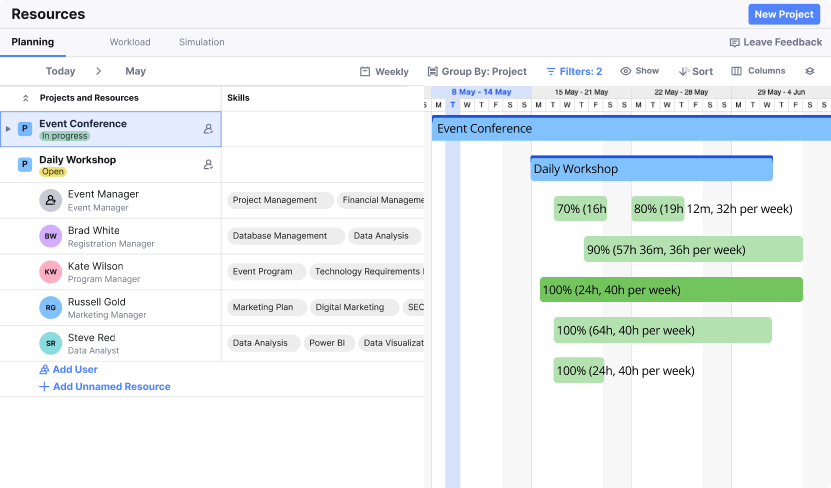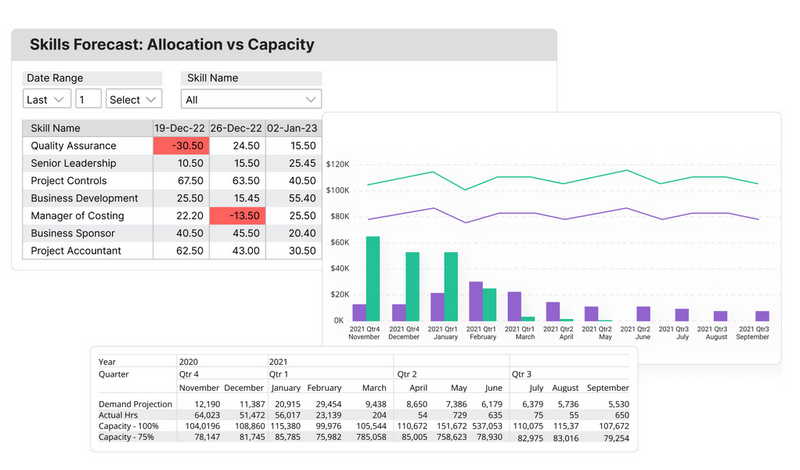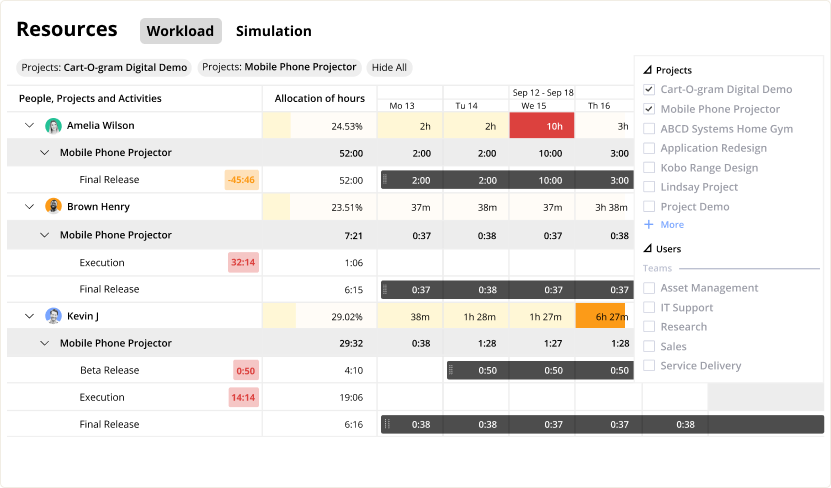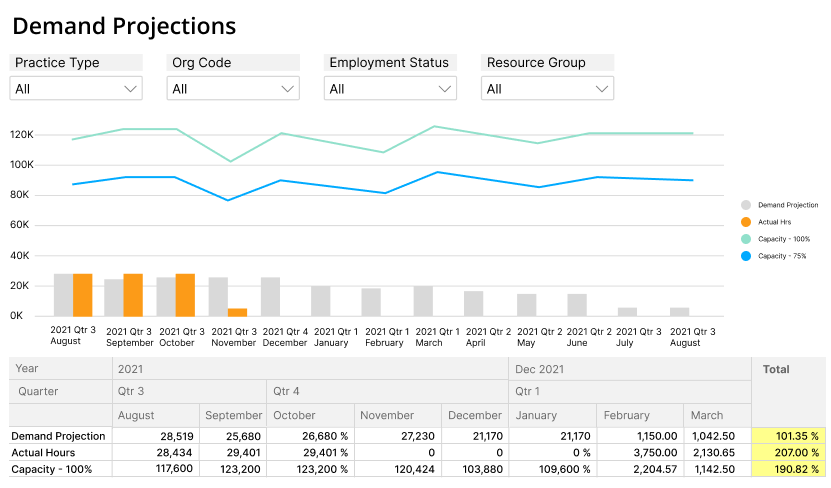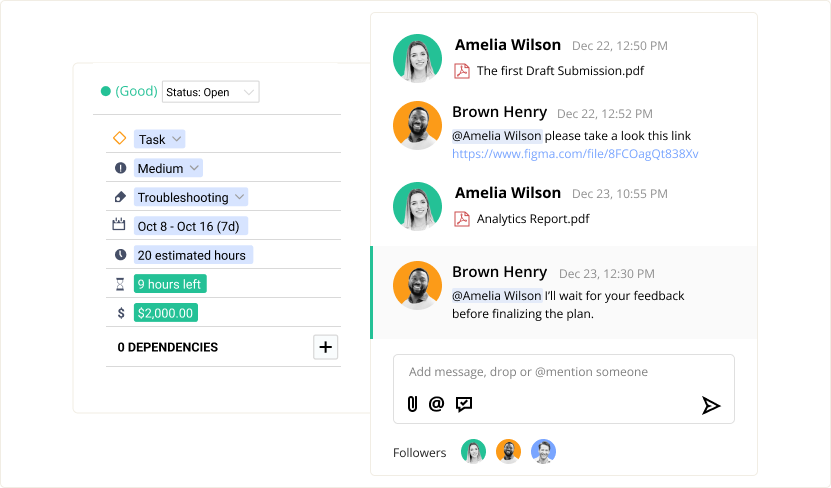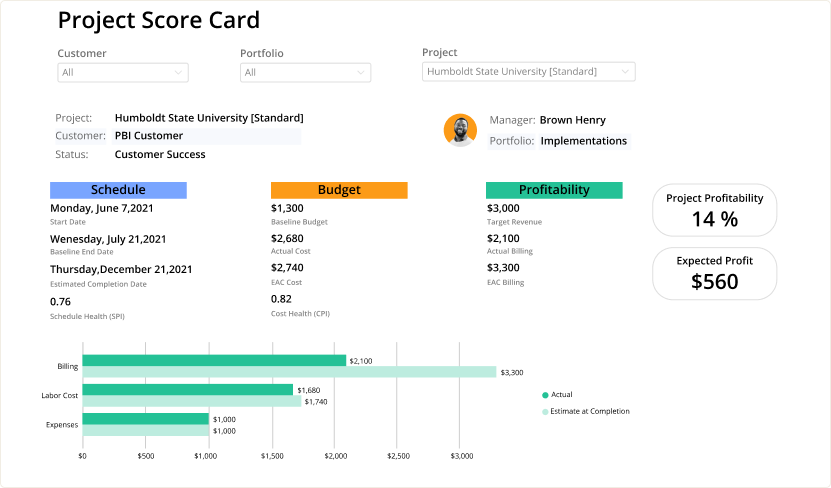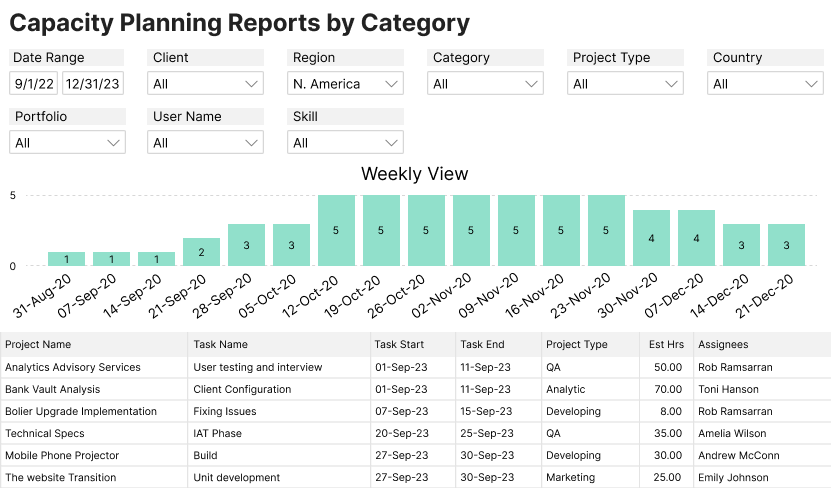In this article, we’ll discuss the critical role that resource forecasting plays in effective resource planning, including how to conduct accurate forecasts and leverage data analysis to make better decisions.
Resource forecasting is a critical part of project management. Its ability to precisely determine the resources required for a project, along with the associated timelines and costs, is invaluable, particularly in engineering firms.
Nevertheless, the process of resource forecasting can be complex. It often encounters challenges that may hinder the accuracy of predictions. As a Delivery or Resource Manager, understanding these challenges is fundamental. This understanding paves the way for better strategies, contributing to improved forecasting accuracy.
Let’s explore these challenges in more detail, seeking to comprehend their origins and potential solutions. By confronting these issues head-on, you’ll be well-positioned to make informed forecasting decisions, leading to more efficient project outcomes.
Pain #1. Uncertain Project Scope
A primary hurdle in resource forecasting is the ambiguity surrounding the scope of projects. Engineering firms frequently manage intricate and evolving projects, making precise estimation of time, effort, and resource needs difficult. This uncertainty can lead to inaccurate forecasting, making it challenging to allocate the right resources at the right time. Recognizing the importance of forecasting in project management, accurate resource forecasting becomes essential for engineering firms to optimize resource utilization, mitigate risks, and ensure successful project execution.
Recipe to Success
To overcome the challenge of uncertain project scope, implementing a few strategic measures can be instrumental.
- Implement an Iterative Planning Approach
Adopt an iterative planning process that allows for regular reevaluation and adjustment of the project scope. This flexibility allows engineering firms to better cope with the inherent uncertainties of complex projects. - Involve Stakeholders Early and Often
Actively involving all project stakeholders from the early stages of project scope definition can help improve the accuracy of the initial project scope and reduce uncertainties later on. - Implement Risk Assessment and Contingency Planning
Regularly conduct risk assessments and develop contingency plans to address potential changes in project scope. This proactive approach can help mitigate the impact of scope changes on resource allocation and project execution. - Leverage Project and Resource Management Software
Utilize resource planning software that provides visibility into staff workload and availability. These tools can indicate if staff members are overloaded or underutilized, providing insights that can assist in early-stage project capacity forecasting. This allows for optimized allocation and better project planning. Project management tools that provide features such as task management, time tracking, and a Gantt chart will help manage project scope, track changes, and improve the accuracy of resource forecasting.
Pain #2: Project Pipeline Uncertainty
Engineering firms often grapple with a pipeline of potential projects, but the precise timing and magnitude of these projects may be unclear. Absent a thorough understanding of the project pipeline, it becomes challenging to accurately forecast the team’s capacity utilization and determine whether additional projects can be accommodated.
Recipe to Success
- Maintain a Detailed and Up-to-Date Project Pipeline
Use project management software to maintain a detailed and up-to-date pipeline of current and future projects. This can provide a visual representation of the project pipeline and improve the understanding of the timing and magnitude of upcoming projects. - Review the Pipeline Regularly
Conduct regular pipeline reviews to adjust forecasts as necessary. These reviews can help the firm adapt to changes and update capacity forecasts in real time, ensuring more accurate resource allocation. - Implement Scenario Planning
Implement scenario planning to account for different possibilities in the project portfolio. By creating different scenarios based on the potential timing and scale of future projects, firms can prepare for various outcomes and make better resource allocation decisions.![]()
Pain #3. Resource Allocation Conflicts
Conflicts in resource allocation can arise when resource forecasting is based solely on historical data or estimates. If multiple projects require the same resources simultaneously, prioritizing and effectively allocating team members becomes difficult. These conflicts can result in delays, lower project quality, or increased team stress.
Recipe to Success
- Use Resource Management Software
By leveraging resource management software for engineering, you can gain a comprehensive view of resource allocation across various projects. This will allow you to identify potential conflicts in real time and address them proactively, thus ensuring more efficient resource utilization. - Communicate
Encourage regular communication within your team to discuss resource allocation and potential conflicts. This can help promote understanding and cooperation among team members, reducing stress and enhancing overall project execution. - Implement a Resource Prioritization System
Create a clear resource prioritization system that takes into account project importance, urgency, and resource availability. This can help in decision-making when conflicts arise, reducing delays and enhancing project quality.![]()
Pain #4. Changing Skill Requirements
As engineering projects evolve, so too might the required skill sets. Forecasting future team capacity becomes challenging with uncertainty about the skills that will be in demand for forthcoming projects. Failing to accurately anticipate and prepare for these changing skill requirements can lead to a shortage of qualified resources, hindering the firm’s ability to take on new projects.
Recipe to Success
- Conduct Assessments
Conduct regular skills assessments to identify the current capabilities of your team and any potential gaps. This will enable you to anticipate the required skills for upcoming projects and take proactive steps to bridge any gaps. - Invest in Learning
Invest in continuous learning and development programs to upskill your team in line with evolving project requirements. This will not only equip your team with the skills needed for current and future projects but also increase team morale and retention. - Establish a Talent Acquisition Strategy
Develop a talent acquisition strategy that considers the evolving skill requirements of your projects. This way, you can ensure you’re attracting and recruiting the right talent that matches the skill demands of your project pipeline.
Pain #5. Inadequate Data Availability
Accurate resource forecasting depends on historical data, such as past project performance, resource utilization rates, and productivity metrics. However, engineering firms may face challenges in collecting and analyzing this data due to inadequate data management systems or inconsistent data capture practices. Without reliable data, informed decisions about resource allocation become challenging.
Recipe to Success
- Collect Relevant and Reliable Data Consistently
Introducing a robust data management system will ensure that you are collecting relevant and reliable data consistently. This system should be capable of capturing data across all key project parameters including resource utilization rates, project performance, and productivity metrics.
- Train Your Team in Data Handling
Regular training on data handling and interpretation will ensure that your team understands the importance of data, how to collect it consistently, and how to use it effectively. This will boost the reliability of your resource forecasting and improve overall project management. - Boost Your Insights with Data Analysis and Interpretation
Using data analysis tools or software can help you understand and interpret the collected data effectively. These tools can provide insights and trends, helping you to make more informed decisions about resource allocation.![]()
Resource forecasting involves input from various stakeholders, including project managers, engineering teams, HR, and finance departments. Yet, ineffective communication and collaboration among these stakeholders can lead to inaccurate resource forecasting. Miscommunication, information sharing delays, or inadequate coordination can cause resource shortages or overallocation.
Recipe to Success
- Establish Effective Communication Channels
Ensure there are clear and defined channels for communication across different departments. Regularly scheduled meetings, shared online platforms, or a dedicated project communication tool can facilitate a timely and accurate exchange of information.
- Promote Cross-Functional Collaboration
Encourage collaboration across various departments involved in resource forecasting. Joint workshops or team-building activities can foster better understanding and cooperation among team members. This way, everyone will be more likely to work towards common project goals.
- Implement Collaborative Planning Tools
Utilize project management software that enables real-time collaboration, document sharing, and task tracking. These tools can help to reduce misunderstandings, improve coordination, and consequently, enhance the accuracy of resource forecasting.![]()
Pain #7. External Factors and Dependencies
Resource forecasting can be influenced by external factors beyond the firm’s control. Changes in regulations, supplier delays, or unexpected market conditions can disrupt project timelines and resource needs. Engineering firms need to account for these external influences and incorporate them into their forecasting models for more accurate resource allocation.
Recipe to Success
- Conduct Regular External Analysis
Keep an eye on the broader business environment. Regularly review changes in regulations, market conditions, or supplier situations that may affect your project timelines and resource requirements. A robust external analysis can help you stay ahead of any disruptions and prepare accordingly. - Incorporate Flexibility into Forecasts
Design your resource forecasting models to be flexible. By factoring in potential external disruptions, your forecasts can be adjusted quickly and efficiently in response to external changes. This level of agility in your forecasting approach helps ensure that your resource allocation remains accurate even under unforeseen circumstances. - Plan for Risk Management
Implement a thorough risk management plan that takes into account potential external factors. This plan should include strategies for identifying risks, assessing their potential impact, and determining appropriate responses. By being prepared for possible external dependencies, you can minimize their impact on your resource forecasting.
Pain #8. Dynamic Project Prioritization
Engineering firms often juggle multiple projects simultaneously, each with its priorities and deadlines. Resource allocation becomes challenging when priorities shift, new projects emerge, or existing projects experience unforeseen delays. Balancing resources while addressing changing project demands necessitates a flexible and adaptive approach to resource forecasting.
Recipe to Success
- Adopt Agile Methodologies
Utilize agile project management methodologies that allow for dynamic prioritization and reprioritization of tasks as project demands shift. This approach ensures that the most critical tasks are always allocated the necessary resources. - Implement Real-Time Resource Management Software
Resource management software can help forecast and adjust resource allocation in real time, accommodating emerging projects and changing project priorities. These software solutions can provide the necessary visibility and flexibility to adapt to shifting project demands. - Develop Contingency Plans
Prepare contingency plans to manage unexpected project delays or sudden shifts in project priorities. Having a backup plan in place can reduce the potential negative impact of these changes and ensure that resources can be reallocated swiftly and effectively when needed.![]()
Pain #9. Limited Visibility of Future Team Capacity
Forecasting potential projects and potential revenue requires a clear understanding of the team’s capacity to handle additional work. However, engineering firms often grapple with limited visibility into their team members’ future availability. Factors such as planned vacations, training sessions, or anticipated personnel changes may impact the team’s capacity but aren’t always considered in resource forecasting.
Recipe to Success
- Develop a Comprehensive Resource Availability Schedule
A schedule that includes all team members’ availability, including planned leaves, training sessions, and anticipated changes, can help provide a clearer picture of future team capacity. This transparency will make resource forecasting more accurate and efficient. - Conduct Regular Team Check-Ins
Encourage regular communication within the team regarding availability and potential changes to their schedules. This proactive approach can help identify potential capacity issues well in advance and allow for more effective resource planning and allocation. - Automate the Tracking Process
The use of advanced engineering resource management software can automate the process of tracking team member availability and aid in capacity forecasting. Such tools can give a real-time view of the team’s current and future capacity, improving forecasting accuracy.![]()
While the resource forecasting process can be rather complex, engineering firms can use resource forecasting tools and software to overcome these challenges. These tools improve data collection, analysis, and stakeholder collaboration, leading to more accurate resource forecasting and better project management outcomes. Automated resource management systems can streamline resource allocation and enable real-time tracking of resource availability and utilization. Recognizing the importance of forecasting in project management and using the right tools can lead engineering firms to overcome these hurdles and achieve more efficient and successful project execution.

